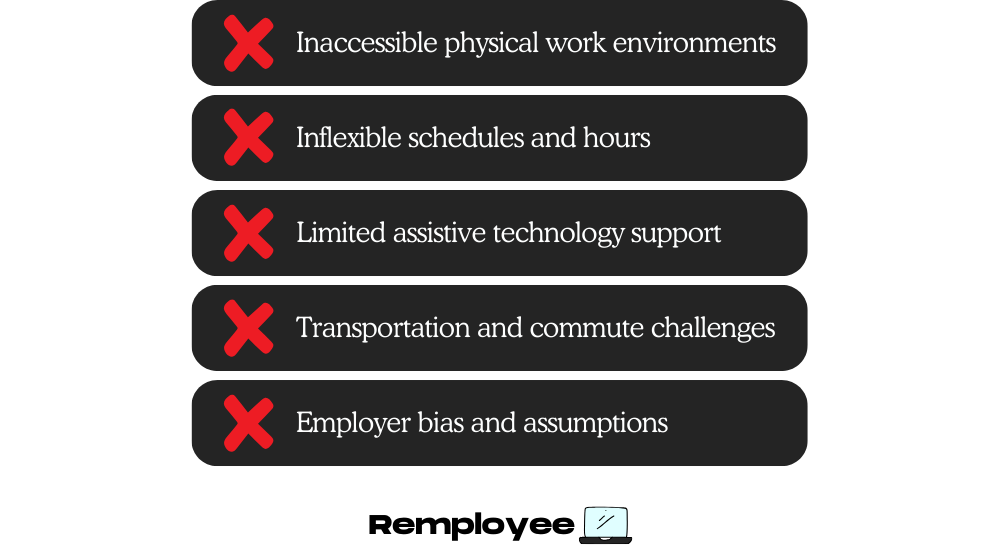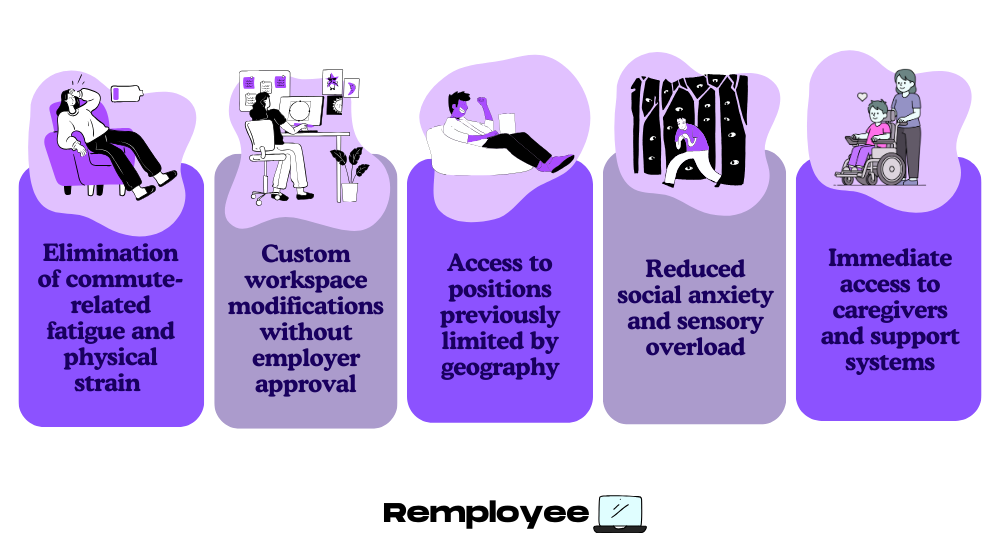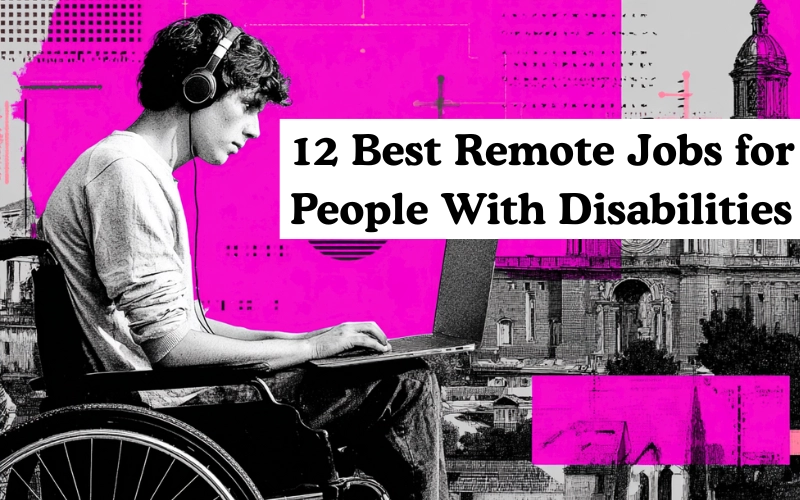Working remotely has cracked open doors that traditional offices kept shut for millions of professionals with disabilities. The commute disappears. The rigid 9-to-5 dissolves. The physical barriers vanish.
Remote work strips away the friction between talent and opportunity, creating pathways where none existed before. For professionals navigating chronic conditions, mobility challenges, or sensory differences, the home office becomes more than convenience—it transforms into possibility itself.
This shift toward distributed work has sparked a fundamental rethinking of accommodation, accessibility, and what meaningful employment looks like when the playing field finally levels out.
What Barriers People With Disabilities Face at Work?

Workplace barriers for people with disabilities extend far beyond wheelchair ramps and accessible parking spaces. Physical obstacles create the most visible challenges—narrow doorways, inaccessible bathrooms, equipment positioned out of reach, emergency exits requiring stair navigation.
Communication barriers silence deaf employees in meetings without interpreters and exclude blind workers from visual-only presentations. Technology barriers emerge through software incompatible with screen readers, videos lacking captions, and platforms that require mouse-only navigation.
The hidden barriers often prove most exhausting:
- Inflexible schedules that ignore medical appointments or symptom fluctuations
- Fluorescent lighting triggering migraines or sensory overload
- Open office layouts overwhelming employees with autism or ADHD
- Mandatory team-building activities excluding those with social anxiety
- Commutes draining energy needed for actual work
- Dress codes incompatible with medical devices or temperature regulation needs
- Unwritten social rules favoring neurotypical communication styles
According to the Bureau of Labor Statistics, only 22.5% of people with disabilities participated in the workforce in 2023, compared to 65.8% of those without disabilities—numbers that expose how these accumulated barriers create systematic exclusion.Retry
How Remote Work Opens More Opportunities?

Remote work dismantles barriers one video call at a time. Professionals control their environments—adjusting lighting, minimizing sensory triggers, keeping medical equipment within reach. Energy once spent navigating inaccessible buildings redirects toward actual work. Flexible schedules accommodate good days and difficult ones alike. The shift has measurable impact:
- Elimination of commute-related fatigue and physical strain
- Custom workspace modifications without employer approval
- Access to positions previously limited by geography
- Reduced social anxiety and sensory overload
- Immediate access to caregivers and support systems
Companies gain access to previously untapped talent pools, while workers with disabilities finally compete on merit rather than proximity.
1. Customer Service Roles You Can Do From Home
Customer service positions have evolved into sophisticated remote operations where empathy and problem-solving matter more than physical presence. These roles offer predictable schedules, clear performance metrics, and technology-driven accommodations. Voice-to-text software supports representatives with hearing differences.
Screen readers enable blind professionals to navigate customer databases. Adjustable break schedules accommodate medication timing or physical therapy needs. Major employers like Amazon, Apple, and LiveWorld actively recruit remote customer service professionals with disabilities, offering comprehensive training programs and assistive technology support.
The work itself builds valuable skills in conflict resolution, technical troubleshooting, and relationship management—competencies that transfer across industries.
2. Virtual Assistant Jobs With Adaptable Schedules
Virtual assistant positions deliver autonomy that traditional administrative roles rarely match. VAs manage email correspondence, coordinate calendars, conduct research, and handle project logistics—all while setting their own boundaries around availability and workload.
This flexibility proves essential for professionals managing unpredictable symptoms or treatment schedules.
Platform companies like Belay, Time Etc, and Fancy Hands specifically seek VAs who thrive in self-directed environments.
3. Freelance Writing and Content Creation Work
Content creation rewards expertise and perspective over office presence. Writers with disabilities bring authentic voices to topics ranging from accessibility advocacy to mainstream business content. The work itself bends around individual needs—write during symptom-free windows, edit when energy permits, research from bed when necessary.
Platforms like Contently, Skyword, and ClearVoice connect writers with brands seeking diverse perspectives. Rates range from $0.10 to $1.00 per word depending on specialization and experience.
Grammar tools, dictation software, and AI assistants level the playing field for writers with dyslexia, motor impairments, or cognitive differences. Publishers increasingly recognize that lived experience with disability enriches storytelling and connects with underserved audiences.
4. Remote Data Entry and Administrative Tasks
Data entry positions offer structured, predictable work that suits professionals who excel with routine and clear expectations. These roles require attention to detail rather than continuous social interaction or physical mobility. Modern data entry extends beyond simple typing—professionals categorize information, verify accuracy, and maintain databases that power business decisions.
Companies like Lionbridge, Clickworker, and SigTrack provide steady streams of data projects with flexible deadlines. Assistive technologies make these positions particularly accessible: eye-tracking software for those with limited hand mobility, voice recognition for typing alternatives, and customizable interfaces for visual impairments.
Pay typically ranges from $12 to $18 hourly, with experienced professionals commanding higher rates for specialized data management.
5. Online Tutoring and Teaching Opportunities
Educational technology has transformed tutoring into a thriving remote profession where subject expertise outweighs physical classroom management. Platforms like Preply, Chegg Tutors, and VIPKid connect educators with students globally, offering complete control over scheduling and workload. Teachers with chronic illnesses schedule sessions around treatment.
Tutors with mobility challenges eliminate classroom navigation entirely. The one-on-one or small group format reduces sensory overwhelm while maintaining meaningful educational impact.
A 2023 survey by Education Week found that 68% of educators with disabilities reported improved work-life balance through online teaching compared to traditional classrooms. Specialized knowledge in test preparation, language instruction, or STEM subjects commands premium rates, often exceeding $40 per hour.
6. Tech Support and Help Desk Roles
Tech support positions leverage problem-solving skills over physical capabilities, making them ideal for professionals who excel at systematic thinking and patient communication. Remote help desk roles operate through ticketing systems, chat interfaces, and screen-sharing software—tools already designed for accessibility.
Companies provide comprehensive training on their specific systems, reducing the need for prior technical certification. Entry-level positions start around $15-20 hourly, while specialized support for enterprise software can reach $35+ per hour.
Organizations like NTT Data, TTEC, and Support.com actively recruit remote technicians with disabilities, offering equipment stipends and flexible shift options. The work builds transferable skills in troubleshooting, documentation, and customer relations while maintaining clear boundaries between work hours and personal time.
7. Graphic Design and Creative Remote Careers
Design work translates seamlessly to remote environments where portfolios speak louder than office presence. Creative professionals with disabilities shape visual communications for brands worldwide, using adaptive tools that accommodate various needs. Pressure-sensitive tablets work for those with limited fine motor control.
Voice commands navigate design software. Color-blind designers use specialized palettes and plugins. The creative process itself adapts to individual rhythms—conceptualize during high-energy periods, execute technical work when focus peaks, iterate based on client feedback asynchronously.
Platforms like 99designs and Dribbble showcase work without revealing personal circumstances.
8. Web Development and Coding From Anywhere
Programming rewards logic and creativity while remaining indifferent to physical location or traditional work schedules. Developers with disabilities contribute to codebases globally, often without colleagues knowing about their accommodations.
The profession naturally supports assistive technology—screen readers parse code, voice recognition writes functions, and customizable IDEs adapt to visual or motor needs. GitHub’s 2023 State of Open Source report found that 23% of contributors identify as having a disability, demonstrating the field’s accessibility.
Bootcamps like Codecademy and freeCodeCamp offer self-paced learning paths. Entry-level developers earn $60,000-80,000 annually, with experienced programmers commanding six figures. The work itself promotes flow states that many neurodivergent developers find therapeutic and engaging.
9. Marketing, Social Media, and Digital Outreach Jobs
Digital marketing thrives on diverse perspectives and authentic voices—qualities that professionals with disabilities bring naturally. These roles span content strategy, campaign management, analytics interpretation, and community engagement, all executable from personalized home setups. Social media management particularly suits those who process communication better through writing than speech.
Marketing automation tools handle repetitive tasks, freeing professionals to focus on strategy and creativity. Companies increasingly recognize that marketers with disabilities understand overlooked market segments representing $13 trillion in annual disposable income globally. Remote marketing positions offer:
- Asynchronous collaboration through project management platforms
- Performance measured by metrics rather than face time
- Creative freedom to develop innovative campaigns
- Flexibility to work during peak cognitive hours
- Access to global opportunities without relocation
10. Transcription and Captioning Work at Home
Transcription services demand accuracy and attention over speed, creating opportunities for professionals who excel at detailed work. Modern transcription extends beyond simple typing—professionals caption videos, create accessible content, and ensure digital media reaches all audiences.
Rev, TranscribeMe, and 3Play Media offer flexible transcription work with no minimum hour requirements. Captioners earn $0.54-$1.10 per video minute, with experienced professionals specializing in medical or legal transcription earning significantly more.
The work directly advances accessibility, giving transcribers with disabilities the satisfaction of expanding access for others. Adaptive equipment like foot pedals, ergonomic keyboards, and speech recognition software make the work sustainable for those with various physical limitations.
11. Project Management Roles With Remote Flexibility
Project management centers on organization, communication, and strategic thinking—skills unaffected by physical location or mobility. Remote PMs coordinate teams, track deliverables, and drive outcomes through digital tools designed for distributed collaboration.
Platforms like Asana, Monday.com, and Trello provide visual project tracking accessible via screen readers. Video calls replace in-person meetings, with recordings available for those who process information better asynchronously. According to PMI’s 2023 Pulse report, 71% of organizations now offer fully remote project management positions, up from 32% pre-pandemic.
Certifications like PMP or Agile remain valuable but experience managing remote teams often matters more. Salaries range from $65,000 for coordinators to $130,000+ for senior positions.
12. Consulting and Coaching From Your Own Space
Consulting transforms expertise into income without traditional employment constraints. Professionals with disabilities leverage years of experience, offering strategic guidance to organizations navigating similar challenges. Disability inclusion consultants help companies build accessible products and inclusive cultures.
Life coaches with chronic illnesses guide clients through health challenges. Business consultants with neurodivergent perspectives identify overlooked opportunities. The consulting model offers complete autonomy—choose clients, set rates, control schedules. Virtual sessions eliminate travel while maintaining personal connection.
Successful consultants build recurring revenue through retainer agreements, creating predictable income that accommodates fluctuating health needs. Hourly rates typically start at $100 for specialized knowledge, reaching $500+ for executive-level advisory work.
Tips for Finding Inclusive Remote Employers
Identifying genuinely inclusive employers requires looking beyond diversity statements to examine actual practices. Companies committed to disability inclusion demonstrate transparency through published accommodation processes, employee resource groups, and accessibility-first job postings.
Search platforms like AbilityJobs, Getting Hired, and Inclusively specifically connect disabled professionals with remote opportunities. Red flags include vague job descriptions, reluctance to discuss accommodations, or surprise video interviews without advance notice. Strong indicators include:
- Clear accommodation request processes on company websites
- Multiple communication options during hiring
- Flexible interview formats offered proactively
- Employee testimonials mentioning disability support
- Partnerships with disability advocacy organizations
Research companies through Disability:IN’s Disability Equality Index, which scores Fortune 500 companies on inclusion practices. During interviews, ask about remote work policies, assistive technology support, and flexibility around medical appointments. Just remember, employers who hesitate to accommodate during hiring rarely improve after employment begins.
Make Remote Work Your Advantage
The shift toward distributed work continues accelerating. Companies that once dismissed remote arrangements now compete for the best talent regardless of location or accommodation needs. This momentum creates unprecedented opportunities for professionals who’ve waited too long for traditional workplaces to catch up.
Your disability brings perspective that enriches teams and drives innovation. The adaptation skills you’ve developed navigating daily challenges translate directly into problem-solving capabilities employers desperately need. Remote work simply removes the artificial barriers between your expertise and organizations ready to benefit from it.
Start with one application. Join one platform. Send one proposal. The remote economy grows stronger when diverse voices contribute to its evolution. Your career belongs in that future.
Ben doesn’t buy into “the way it’s always been done.” He’s spent his career challenging hiring norms and rethinking how remote work should feel. At Remployee, he helps create honest tools and opportunities for people tired of the gig economy’s empty promises.



